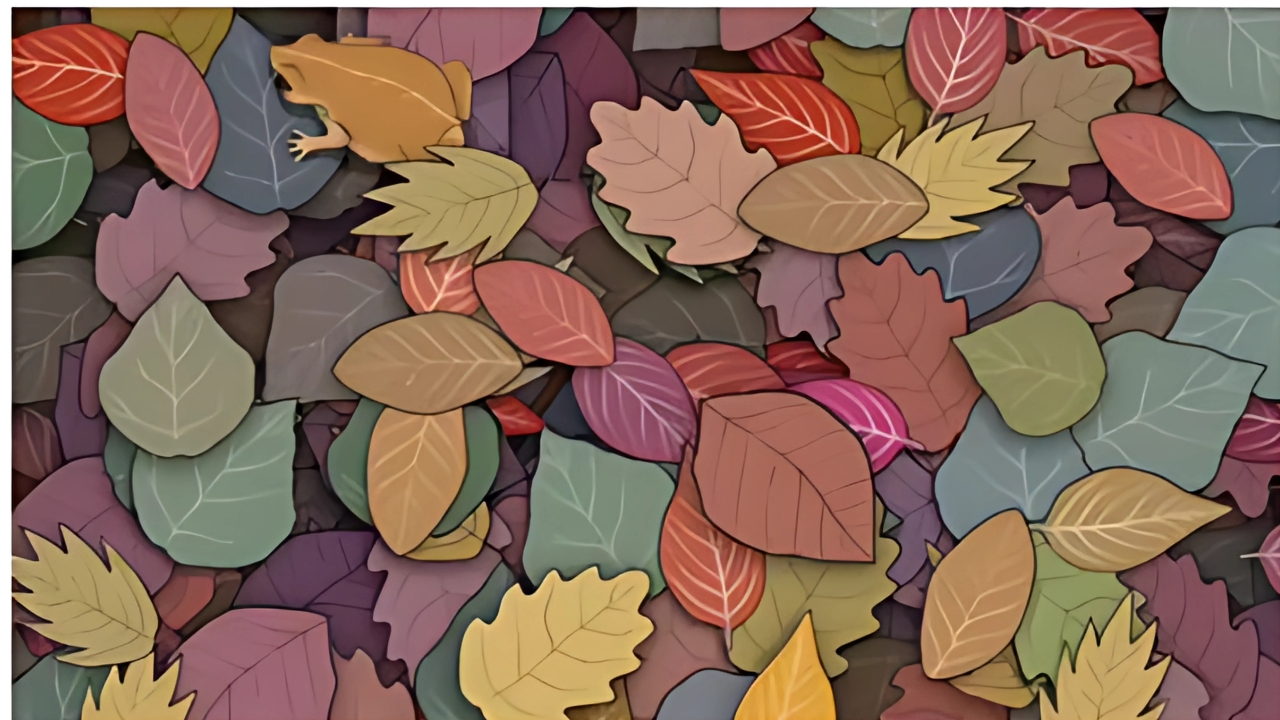Can You See the Frog : Optical illusions have fascinated humans for centuries, captivating our minds with their ability to trick our perception. These visual puzzles challenge our understanding of reality, often hiding objects in plain sight that require keen observation to uncover.
One such intriguing example is the image of a pile of colorful autumn leaves concealing a frog. At first glance, the image appears to be a simple collection of leaves in various shades of green, yellow, brown, and purple. However, hidden within this vibrant mosaic is a frog, blending seamlessly with its surroundings.
This article explores the phenomenon of optical illusions, the psychology behind them, the specific challenge of spotting the frog, and tips to enhance your ability to perceive hidden elements in such images.
The Fascination with Optical Illusions

Optical illusions occur when our brains misinterpret visual information, leading us to see something that isn’t there or fail to see something that is. This happens because our brain relies on patterns, past experiences, and assumptions to process visual data quickly. When an image disrupts these patterns—such as by blending colors, shapes, or shadows—our perception can be deceived. The frog hidden among the leaves is a classic example of a camouflage illusion, where the subject mimics its environment to avoid detection.
Historically, optical illusions have been used in art, science, and even warfare. Artists like M.C. Escher created mind-bending works that play with perspective and impossible constructions, while naturalists study camouflage in animals to understand survival mechanisms. The frog in the leaf pile taps into this rich tradition, challenging viewers to look beyond the obvious and engage with the image on a deeper level.
The Psychology Behind the Challenge
The human brain is wired to recognize familiar shapes and patterns, a skill honed through evolution for survival. However, this same ability can work against us when faced with illusions. In the case of the frog hidden among the leaves, our brain might initially categorize the image as a random assortment of foliage, overlooking the subtle differences that indicate the presence of an animal. The frog’s coloration and shape are designed to mimic the leaves, exploiting our tendency to overlook anomalies unless we actively search for them.
Cognitive psychologists suggest that solving optical illusions requires a shift in attention. This involves moving from passive viewing to active exploration, where the viewer scans the image for irregularities in color, texture, or shape. The challenge of spotting the frog thus becomes a test of both perception and patience, engaging the brain’s visual cortex and problem-solving centers.
Spotting the Frog: A Step-by-Step Guide
To locate the frog in the image, start by examining the overall composition. The leaves are scattered in a seemingly random pattern, with a mix of warm and cool tones. The frog is likely to blend into this palette, using its natural camouflage to merge with the background. Look for areas where the leaf shapes seem slightly irregular—perhaps a leaf with an unusual curve or a patch of color that stands out just enough to suggest a different texture.
One effective strategy is to break the image into sections and scan each part methodically. Begin at one corner and move your gaze slowly across the image, paying attention to the edges and overlaps of the leaves. The frog may be partially obscured, with only part of its body visible. Its eyes, legs, or a distinctive outline might be the first clues to its location. Another technique is to adjust your focus—looking slightly away from the image or squinting can sometimes reveal hidden details by altering how light and shadow are perceived.
If you’re still struggling, try inverting the image mentally or physically. This can disrupt your brain’s initial assumptions and highlight the frog’s presence. Patience is key; optical illusions often reward those who take the time to observe rather than rushing to a conclusion. Once you spot the frog, it may become impossible to unsee, a common phenomenon known as the “aha!” moment in perceptual psychology.
The Science of Camouflage
The frog’s ability to blend into the leaf pile mirrors real-world camouflage seen in nature. Many animals, such as chameleons, octopuses, and certain frogs, use color and pattern matching to evade predators or ambush prey. The frog in the illusion likely draws inspiration from species like the green tree frog or the leaf frog, which have evolved to resemble their leafy habitats. This natural adaptation is a survival strategy, but in the context of the illusion, it becomes a playful challenge for the viewer.
Scientists study camouflage to understand how visual perception works across species. For humans, detecting a camouflaged animal requires overcoming our brain’s tendency to group similar elements together. The frog’s success in hiding depends on its ability to break this grouping, using the leaves’ colors and shapes as a shield. This interplay between nature and perception makes the illusion both educational and entertaining.
Enhancing Your Illusion-Solving Skills
Regular practice with optical illusions can sharpen your observational skills. Start with simpler images, such as those hiding basic shapes, before progressing to more complex scenes like the frog among the leaves. Games and puzzles that involve finding hidden objects can also train your brain to notice subtle differences. Additionally, taking breaks during the search can refresh your focus, preventing eye strain and mental fatigue.
Lighting and screen settings can also affect your ability to see the frog. Adjust the brightness or contrast of your device to reduce glare and enhance detail. Viewing the image from different angles or distances might also help, as perspective shifts can reveal hidden elements. Over time, you may develop an intuitive sense for spotting camouflaged objects, turning the challenge into a rewarding hobby.
The Cultural Impact of Optical Illusions
Optical illusions have transcended scientific study to become a cultural phenomenon. They appear in children’s books, social media challenges, and viral trends, engaging people of all ages. The frog hidden in the leaves is a modern example of this trend, shared widely online as a test of visual acuity. Such challenges foster a sense of community as people compare their experiences and share tips for finding the hidden subject.
This particular illusion also taps into our fascination with nature. Frogs symbolize transformation and adaptability in many cultures, and their presence in the image adds a layer of symbolic depth. Whether viewed as a puzzle or a work of art, the image invites viewers to connect with the natural world in a unique way.
Optical Illusion Answer

The optical illusion of the frog hidden among the leaves is more than just a visual puzzle—it’s a window into the workings of the human mind and the wonders of nature. By challenging our perception, it encourages us to slow down, observe closely, and appreciate the complexity of the world around us.
Whether you’ve already spotted the frog or are still searching, the experience highlights the joy of discovery that optical illusions provide. So, take another look, apply the strategies outlined, and enjoy the thrill of uncovering the hidden frog amidst the autumn leaves.
